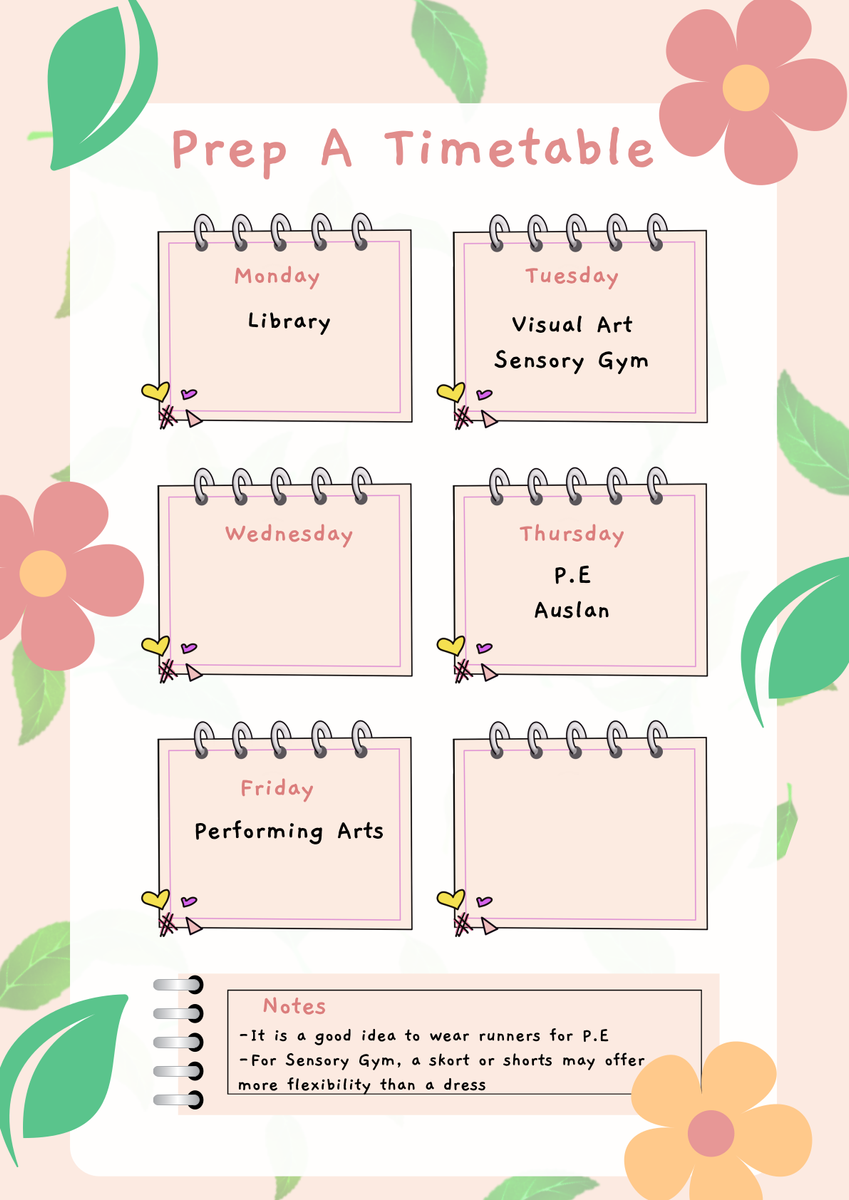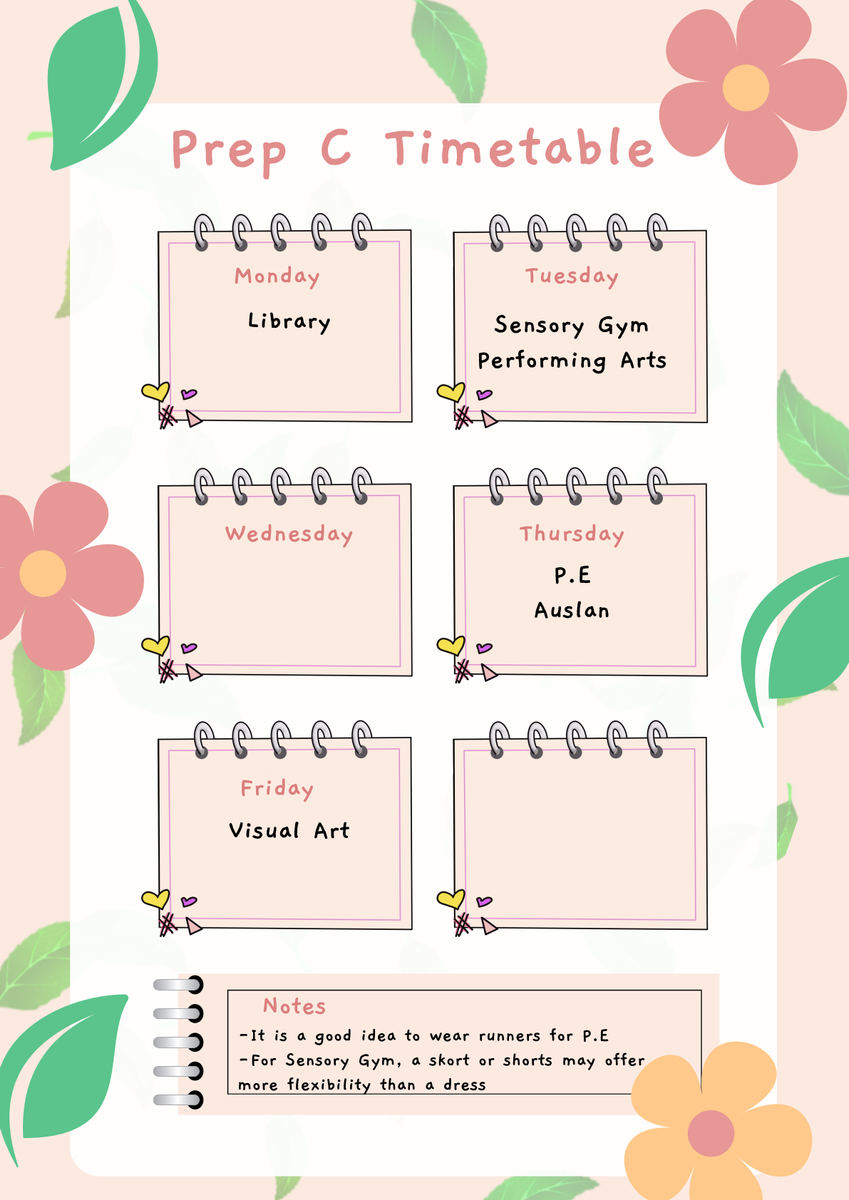Prep Wonga Weekly
Week 2, Term 2

Prep Wonga Weekly
Week 2, Term 2
-INFORMATION
🗓️ Upcoming Dates:
Monday 28th April: Cyber Safety Session
Wednesday 30th April: ANZAC Day assembly, 9am
Wednesday 30th April and Friday 2nd May: iPad connection to school network. Please remind your child to bring their iPad to school on these days
Monday 5th May: Students can bring ipads to school
Wednesday 7th May: Mother's Day Morning, 8.30 - 10am
iPads
iPads need to be brought to school on Wednesday and Friday this week, so that our IT technician can connect iPads to our server.
Please ensure that you have given permission via Sentral.
Emails regarding iPads were sent home last week, so please check those for more detail information.
Frequently Asked Questions:
How are iPads used in Prep?
In Prep, iPads are used thoughtfully to support and enhance student learning in a variety of ways:
Will Preps still do handwriting?
Absolutely! Handwriting remains an essential part of our program and plays a vital role in developing both reading and writing skills. While iPads are a wonderful tool to support learning, they certainly don’t replace the importance of handwriting in Prep.
Do I need to provide my child with an iPad?
If you’re able to provide a 1:1 iPad for your child, it offers wonderful benefits for their learning, including easy access to assistive technology and a range of educational tools.
If this isn’t possible, we do have a limited number of school devices that can be shared when available. Of course, non-technology learning options will always be provided as well.
Will students play games on their iPad?
If games are used in class, they will be carefully selected by teachers to be educational, purposeful, and connected to current learning. Students won’t be playing personal or home-based games like Roblox at school.
Additionally, iPads are never used during indoor, wet weather recess or lunch times — these breaks remain screen-free opportunities for rest, play, and social connection.
🗣️ NEW! Show and Share
Next week, we’re excited to begin Show and Share, which supports our learning in Speaking and Listening as well as our CBL program.
Each week, students will have the opportunity to share with the class based on a set topic. Some students will share on Wednesdays, while others will share on Fridays.
The topics for this term are listed below. We will also add a copy of this into each child's book pocket.


📚 Book Pocket Reminders and tips
NEW! Please remind your child to bring their book pocket to school on Monday, Wednesday and Friday.
-Re-reading these texts at home is highly beneficial because fluency matters. Fluency is key to becoming a strong reader and develops with repetition and practice. Fluent reading should be smooth and sound natural. Once your child has decoded (sounded out) the words, encourage them to re-read the passage with fluency.
-Reading Logs: They are checked every Friday - please remember to record the name of the book that your child has read in this log.
A note on phonemic awareness and decoding:
Blending three sounds to read words is a new skill for most Prep students. Developing phonemic awareness takes time and practice! (Phonemic awareness is the ability to hear, identify, and manipulate sounds in spoken words.)
-Try orally segmenting a three-letter word for your child (e.g., c-a-t), making sure to stretch the sounds so the word is easier to hear. Have your child listen and then say the whole word.
-If your child finds reading passages challenging, focus on individual words within the text and decode them together (e.g., p-o-t … pot).
🎨 Specialist timetable






🔤 NEW! UFLI Practise Pages
Starting this week, we will be including optional UFLI practice pages in the Wonga Weekly. Below, you'll find an explanation from the UFLI team on how to use these pages effectively.


CURRICULUM
📚 Phonemic awareness: reading and phonics
This week, we are focusing on the letters C and the short U vowel sound (as in umbrella). Students will explore the phonemes (the sounds they make), the graphemes (how they are written with correct letter formation) and the corresponding cued articulation.
Additionally, students will practice reading and writing CVC words with the medial vowels A, I, O and U (where the vowel appears in the middle of the word).
For sight word practice, students will review the Heart Words: the, and, I, a, and is, while also learning the new word as.
What can you do at home?
-Read bedtime stories to your child
-Assist your child to read their take home book / decodable passages / CVC words in their book pocket
-If you're interested in Cued Articulation, you can watch Jane Passey (the founder) explain what it is. She also demonstrates the cued articulation for each phoneme.
https://www.youtube.com/watch?v=gyGX3RcLG74&ab_channel=cuedart48
-Work through the optional UFLI home practice pages




📝 Literature: reading responses and writing
This week, students will explore the beautifully written book Come Over to My House by Eliza Hull and Sally Rippin. This thoughtfully chosen mentor text aligns with our new CBL Guiding Questions and centres around the important theme of inclusion.
Through this story, students will begin to understand the concept of disability and how families can support members who may need adjustments. They’ll engage in rich discussions about the characters, reflect on how kindness and inclusivity are shown and practise identifying and analysing character traits.
Students will also focus on rhyming. Using the text as a springboard, they’ll learn to listen carefully to ending sounds to identify rhyming words—focusing on sounds rather than spelling. This helps develop both phonological awareness and a love for playful language.
By the middle of this week, we will know four vowels - A, I, O and U - allowing us to form more even more CVC (consonant-vowel-consonant) words. Using these words, we will write simple sentences.
Students will also practice handwriting with a focus on the letters C and U, while reviewing the formation of previously learned letters.
What can you do at home?
-Play with things that develop fine motor skills like lego, playdough, drawing and building blocks
-Help your child develop their pencil grip
-Write the letters A, M, S, T , P, F, I, N, O, D, C and U using taught lower case formations. Use these letters to write some words, using short A, I, O and U as the middle vowels.
🔢 Maths
This week, students are developing their number sense through subitising—the ability to instantly recognise how many items are in a small group without counting. They’ll be working on subitising numbers up to 10 and then extending this skill to 20. Students will learn to subitise more efficiently by recognising parts of a group without needing to count every item. They’ll also compare quantities and practise estimating collections of up to 20 using their subitising skills.
What can you do at home?
-Play board games that use dice to help your child quickly recognise dot patterns without counting.
- Play with dot cards or flashcards. For example, show cards with different dot patterns briefly and ask, “How many?” without giving time to count.
- Build with blocks or LEGO – Make small groups and ask your child to guess or compare quantities quickly. Talk about how they see numbers. Ask, “Did you see two groups of 3?” to help them visualise numbers in chunks.
🌏 CBL - Diversity
This term, our Prep students will be exploring the Big Idea of Diversity. Through guided inquiry and thoughtful discussions, they’ll begin to understand what it means to be respectful and inclusive in a diverse community.
Students will identify and describe different ways to show respect in intercultural settings and explore the cultural diversity that exists in the familiar places around them—such as school, family, and the local community.
To support their learning, students will be guided by the following questions:
Guiding Questions:
-Who are the people and groups that make up our local community?
-What kinds of diversity exist within our local community?
-Why is it important to recognise and value diversity?
Essential Question:
-How can we show respect and understanding while embracing diversity?
Challenge:
-Find a meaningful way to show appreciation for the diversity in our community.
We’re excited to see the thoughtful and creative ways our students engage with these ideas as they continue to build empathy, respect, and understanding.
💛 Wellbeing & School Wide Positive Behaviour (SWPBS)
In Friendology, students are completing Session 6 called Friendship Fires. This session teaches students, step-by-step, how to resolve conflict with a friend and how to respond to hurt feelings and misunderstandings.
The 3 Steps are:
1.Retell the situation being as specific as possible.
Example: “Remember when I showed you my wiggly tooth and you said it was gross…”
2.Explain how it made you feel.
Example: “I felt sad. I felt like you were making fun of me.”
Note: Avoid saying things like, “You made me feel…” or “You were being…” or “That was mean!” The focus is on how the affected student felt, using an I-statement.
3.Listen to what the other person is saying. Truly listen to their side of the story.
-Apologies might need to be made, and a plan devised to try and avoid a similar situation in the future.
What can you do at home?
If your child shares their hurt feelings or a misunderstanding with a friend, you can help them practice resolving the conflict using the steps above.
Our SWPBS focus remains on the expectations of 'Be Kind' and 'Be Safe.' We continue to encourage inclusivity in games and making safe choices about where and how we play. Our understanding of 'Be Safe' also extends to classroom behaviour, including walking indoors and transitioning quickly and quietly between lessons